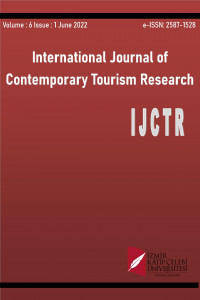EXAMINATION OF THE CULTURAL TOURISM PERCEPTION OF SAFRANBOLU IN TERMS OF DOMESTIC TOURISTS’ TRAVEL BEHAVIOURS
EXAMINATION OF THE CULTURAL TOURISM PERCEPTION OF SAFRANBOLU IN TERMS OF DOMESTIC TOURISTS’ TRAVEL BEHAVIOURS
Turkey is a country that has a lot of historical and important concrete and non-tangible cultural heritage in every direction that many civilizations have experienced in the past. Especially when cities are presented as destinations, these historical and cultural values are seen as an important attraction factor for tourists towards the region. In addition, taking the cities to UNESCO's list of cultural heritage is an important element that makes it interesting for domestic and foreign tourists. One of the UNESCO-registered regions is Safranbolu. Especially since 1994, With the receipt of UNESCO has been recognized as a cultural heritage list, this region has been recognized and has become an important destination for cultural tourism by domestic and foreign tourists. The aim of working in this context is to ensure that the perspectives of local tourists to Safranbolu as a cultural destination are determined. In addition, depend on the demographics of the tourists coming to the region, whether the perceptions have changed or not, and the satisfaction levels of tourists coming to Safranbolu and their repeat visits will also be revealed. For this purpose, data were collected from 290 domestic tourists coming to Safranbolu by questionnaire method. The data were analyzed in the SPSS 22 packet program. According to the analysis results obtained, it has been determined that the cultural tourism perception of Safranbolu differs depending on the number of visits of domestic tourists and duration of visits. On the other hand, it was determined that the fact that a large majority of domestic tourists coming to Safranbolu are satisfied with the travel and are tended to recommend it to others but they were not as positive as the other two variables in traveling to Safranbolu again.
Keywords:
Safranbolu, Cultural Tourism, Travel Behaviours Domestic Tourists, Safranbolu,
___
- Aydın, (1990). Açıklamalı Turizm Terimler sözlüğü, Aydın.
- Barlas, U. (2004). Safranbolu Kültür Tarihi Araştırmaları 1. Baskı, İstanbul: Senfoni matbaası Batu,
- Batu, A. ve Batu, H.S (2016). Türk tatlı kültüründe Türk lokumunun yeri, Journal of Tourism and Gastronomy Studies 4(1), 42-52.
- Doğaner S. (2013). Türkiye Kültür Turizmi. 1. Baskı, İstanbul: Doğu kitapevi
- Doğaner, S. (2001). Türkiye’nin Turizm Coğrafyası. Çantay Kitabevi İstanbul.
- Du Cluzeau, C. O. (2000). Le Tourisme Culturel. Paris: Presses Universitaires de France
- Fainstein, S. S. (2007). Tourism and the commodification of urban culture, The Urban Reinventors, 2, 1-17. Field, A. (2000), Discovering statistics using SPSS for Windows, London: SAGE Publication.
- Gürbüz, A. (2002). Turizmin sosyal çevreye etkisi üzerine bir araştırma, Teknoloji Dergisi, Sayı 1-2.
- Hughes, H. L. (2002). Culture and tourism: a framework for further analysis”, Managing Leisure, Routledge Taylor&Francis Group, 164- 175.
- Jurdana, D. S. ve Z. Susilovic. (2006). Planning city tourism development: principles and ıssues, Tourism and Hospitality Management, 12(2), 135-144.
- Karabük Valiliği (2012). Karabük Safranbolu Gezi Rehberi. ISBN. 978-605-359-530-4.
- Le Robert Quotidien: Dictionnaire Pratique de la Langue Française (1996). Paris: Le Robert.
- Macdonald, G. M. E. (2004). Unpacking Cultural Tourism. Unpublishing MBA Thesis. Simon Fraser University, School of Communication.
- McKercher B. and Du Cros, H. (2002). Cultural Tourism: The Partnership Between Tourism and Cultural Heritage. New York: Haworth Hospitality Press Inc.
- Meydan Uygun, S. ve Baykan, E. (2007). Kültür turizmi ve turizmin kültürel kültür turizmi ve turizmin kültürel varlıklar üzerindeki etkileri, Ticaret ve Turizm Eğitim Fakültesi Dergisi Yıl: 2007 Sayı: 2, 30-49.
- Moran, Y. (1992). Eşanlamlı Sözcükler ve Karşıt Anlamları Sözlüğü. İstanbul: Spatyom Yayınları.
- Nunnally, J. C. ve Bernstein, I.H. (1994). Psychometric theory. Third Edition, New Jersey: McGraw-Hill Inc.
- Öztürk, Y. ve Yazıcıoğlu, İ. (2002). Gelişmekte olan ülkeler için alternatif turizm faaliyetleri üzerine teorik bir çalışma, Gazi Üniversitesi Ticaret Ve Turizm Eğitim Fakültesi Dergisi, (2), 183-195.
- Scherer, R. Wiebe, F..A., Luther, D.C. & Adams, J.S. (1988). Dimensionality of coping: Factor stability using the ways of coping questionnaire, Psychological Report, 62, 763-770.
- Tapur, T. (2009) Konya ilinde kültür ve inanç turizmi, Uluslararası Sosyal Araştırmalar Dergisi, 2(9), 473-492.
- Uca Özer, S. (2010). Şehir Turizmi ve Kültür: Yabancı Turistlerin Kültürel Bir Destinasyon Olarak İstanbul’u Değerlendirmeleri Üzerine Bir Araştırma. Yayınlanmamış Doktora Tezi. Anadolu Üniversitesi, Eskişehir.
- Ulukavak, K. (2007). Bir Safranbolu’lunun Penceresinden Safranbolu, Bizim Büro Kitabevi, Ankara.
- Usal, A. ve Kuşluvan, Z. (2002). Davranış Bilimleri, Sosyal Psikoloji, İzmir: Barış Yayınları.
- Üsküdar, Ş., Çakır, M. ve Temizkan, S. P. (2014). Yerli turistlerin Eskişehir’in kültür turizmine ilişkin algıları, Journal Of Tourism and Gastronomy Studies, 2(2), 67-76.
- Werding, K. (2003). Cultural Heritage Tourists, Kentucky Artısan Heritage Trails.
- Başlangıç: 2016
- Yayıncı: İzmir Katip Çelebi Üniversitesi
Sayıdaki Diğer Makaleler
AVRUPA’DAN TÜRKİYE’YE YÖNELİK TURİZM AKIMLARININ PANEL ÇEKİM MODELİ İLE ANALİZİ
Cenk Murat KOÇOĞLU, Bilge Özge BOZTEPE
Turizm Öğrencilerinin Etik Bilinci, Niyeti ve Yöneliminin Çok Boyutlu Bir Analizi
TERMAL TURİZMDE YERLİ TURİSTLERİN SEYAHAT MOTİFLERİ VE HİZMET BEKLENTİLERİ
YERLİ ZİYARETÇİLERİN ÇEVRESEL SÜRDÜRÜLEBİLİRLİK ALGISININ BELİRLENMESİNE YÖNELİK BİR ARAŞTIRMA
THE CONSUMPTION OF LOCAL FOOD IN RESTAURANTS: A STUDY IN KAS
